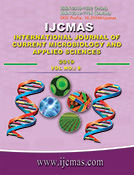


 National Academy of Agricultural Sciences (NAAS)
National Academy of Agricultural Sciences (NAAS)

|
PRINT ISSN : 2319-7692
Online ISSN : 2319-7706 Issues : 12 per year Publisher : Excellent Publishers Email : editorijcmas@gmail.com / submit@ijcmas.com Editor-in-chief: Dr.M.Prakash Index Copernicus ICV 2018: 95.39 NAAS RATING 2020: 5.38 |
The Narmada is the largest west-flowing peninsular river ranks seventh in terms of water discharge (38km3/yr) in India. A number of dams have been constructed on the Narmada River and its tributaries, mainly for the purpose of electric power generation, irrigation and for controlling floods. The objective of this paper is to calculate minimum flow of Narmada River which is necessary to protect ecosystem and biodiversity at downstream site of dam which is constructed across Narmada River and its tributaries. In the present study, the flow data was analyzed for four stations (Sandia, Barman, Dindori, and Manot gauging stations) in Narmada basin using Global Environmental Flow Calculator (GEFC) developed by International Water Management Institute (IWMI) Shri Lanka. It is built around a period-of-record flow duration curve (FDC) accumulative probability distribution function of flows and includes several subsequent steps. The environmental flow requirement (EFR) for protection of biodiversity and ecosystem of River minimum flow should be 46% of MAR (Mean Annual Runoff) at barman station, 45.1% of MAF at Sandia station and 36.1% at Dindori station and 24.3% of MAR at Manot station of Narmada basin.
 |
 |
 |
 |
 |